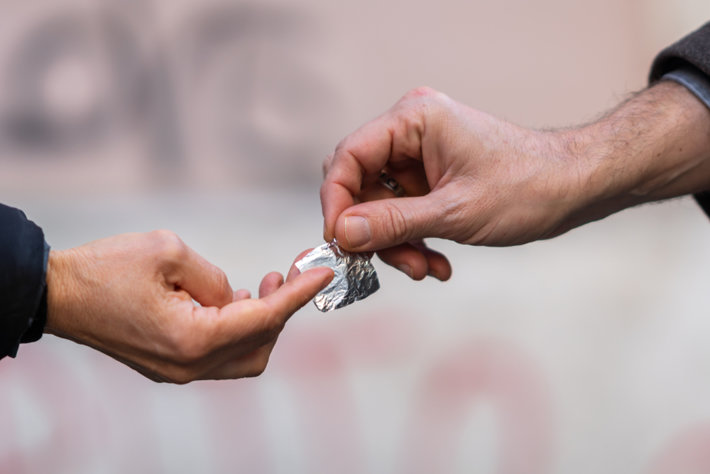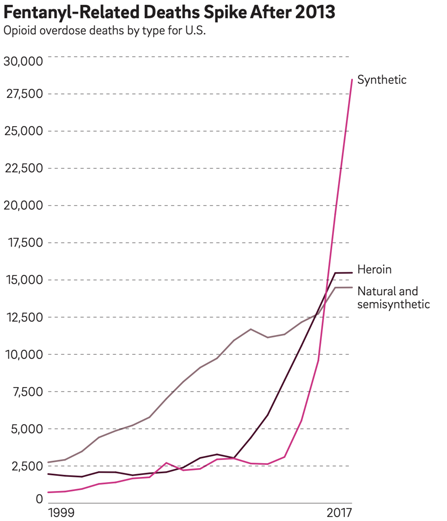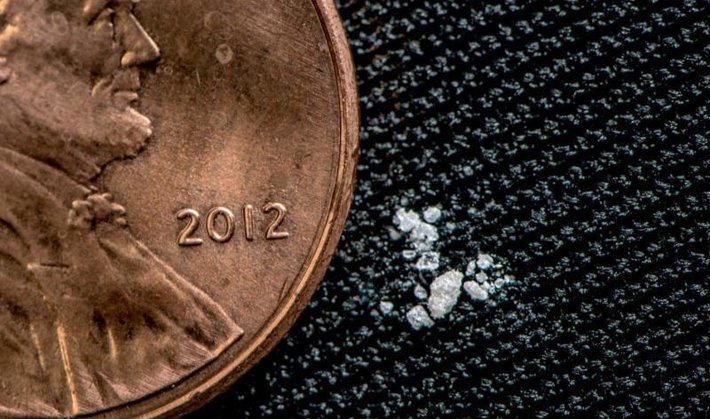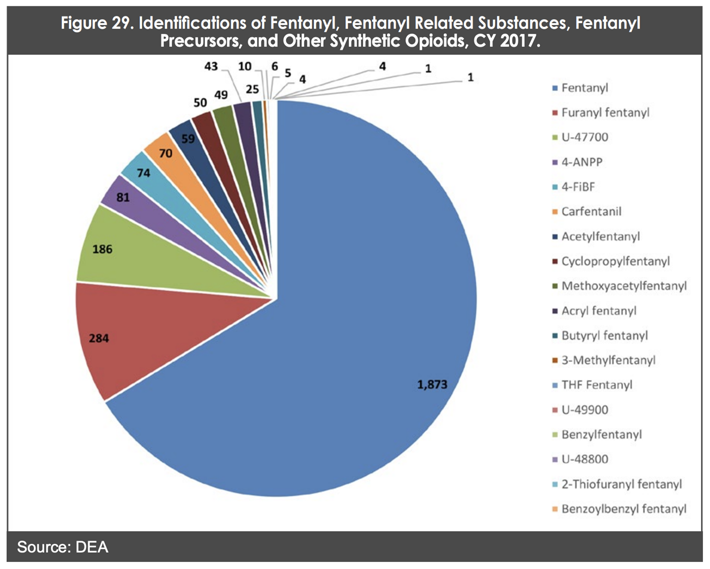An Update on the Lethal Synthetic Opioid Fentanyl

This single chart sums up the horrific dangers associated with fentanyl, a synthetic opioid that is, in most cases, trafficked into the United States from Asian manufacturers. See the red line labeled “synthetic.” That line shows you how many people have died, year by year, after consuming the synthetic opioid fentanyl. This makes fentanyl Public Enemy #1 for anyone who’s using opioid drugs of any kind.

That’s because a person who buys opioids never knows exactly what they are getting unless they are a chemist. They could buy whitish powder on the East Coast, thinking it’s heroin and learn that it’s actually just fentanyl plus inert ingredients.
They could buy black tar heroin on the West Coast, only to discover that their drug supplier has figured out how to adulterate sticky black tar heroin with fentanyl.
Or they could buy pills from a drug dealer, hoping that they are the real thing, and actually end up with fentanyl, filler and coloring material shaped to look like their favorite pill.
Few go looking for fentanyl and find it, but even then, they don’t know the potency they are buying.
Potency is Key
Fentanyl is vastly more potent than the purest form of heroin on the market. This is why it’s so dangerous. Drug dealers mixing this drug into inert materials or their supply of heroin very often leave “hot spots” in their mix—areas where the fentanyl is clumped up, poorly mixed into the carrier substance. When this batch is distributed into little glassine envelopes or pressed into pills, some of the doses are going to be killers and the others will be weaker and not result in fatalities.
Drug dealers are counterfeiting all kinds of popular painkillers, substituting fentanyl for oxycodone, hydrocodone, hydromorphone or other opioids. And it’s not just painkillers these drug dealers are counterfeiting. Fentanyl can also be found in non-opioid drugs like alprazolam (brand named Xanax).
Samples of fentanyl seized by law enforcement show a range from 0.1 percent purity to 97.8 percent. Because fentanyl is 50 to 100 times more powerful than morphine and 5 to 10 times more powerful than heroin, it’s easy to see how a person can receive an overdose of this drug.
It’s important to realize that the word “fentanyl” refers not just to one drug but to dozens. It’s an entire family of chemically-similar drugs. These similar drugs have been called “analogues” but now are starting to be referred to as “fentanyl-related substances” or FRS.
Here are some of the drugs in this family and their potency when compared to morphine.
- Fentanyl 50 times stronger
- Butyrylfentanyl 6
- Acetylfentanyl 17
- Remifentanil 50
- Ocfentanil 125
- Furanylfentanyl 350
- Sufentanil 500
- Cis-3-Methylfentanyl 1,000
- Carfentanil 10,000 (only legitimate use is for large animals)
There’s also a drug cocktail that usually contains heroin, fentanyl, carfentanil and another FRS referred to as U-47700. This mixture is sold as a hard, chunky material or a finer powder and has been nicknamed “gray death.” This drug has been found in Alabama, Indiana, Georgia, Ohio, Pennsylvania, and New York. More than 50 people died from overdoses of this drug in Georgia, mostly in the Atlanta area.
Fentanyl has also been found in cocaine, methamphetamine and MDMA/ecstasy.
Just to give you an idea of the strength of fentanyl, most people will fatally overdose on this quantity of pure fentanyl.

Photo source: U.S. Customs and Border Protection
On the following chart, you can see what types of fentanyl are being seized. Plain fentanyl constitutes about two-thirds of all FRS seizures.

Where is it Coming From?
Originally, fentanyl was coming from China, India and Pakistan. Now, the primary manufacturing sources are in China and Mexico. Some supplies are also coming from Thailand.
It comes into the U.S. via Mexico, or drug dealers purchase it from dark web sites and have it shipped directly to them. They may also purchase pill presses and the materials they need to make counterfeit prescription drugs.
When the drug transits the Southwest border, the shipments are usually larger, but the potency is typically low, often less than 10 percent. When the drug is shipped directly from China to the drug dealer, purities may be higher than 90 percent.
Who is Consuming Fentanyl?
Anyone who normally consumes heroin or any type of painkiller is a potential consumer of fentanyl. In 2016, there were 3.4 million people misusing their prescription painkillers and 475,000 heroin users.
Just to give you an idea of how much fentanyl or FRS is circulating through our society, here are the number of samples of some of these drugs supplied to the national forensics lab.
- Fentanyl 34,204 samples
- Acetylfentanyl 1,669
- Furanylfentanyl 2,273 (there were zero samples submitted in 2015)
- Carfentanil 1,100 (again, zero samples in 2015)
- Butyrylfentanyl 93
Opioids Such as Fentanyl are the Leading Cause of Overdose Deaths
According to the Centers for Disease Control and Prevention, fentanyl is now the number one drug involved in overdose deaths. In most of these deaths, there may be multiple opioids and multiple types of drugs involved in killing the person. It’s difficult to define exactly which drug pushed the person over the edge, slowing down their breathing until they asphyxiate.
Between 2011 and 2016, these were the most frequently-mentioned drugs in overdose reports:
Fentanyl, heroin, hydrocodone, methadone, morphine, oxycodone, alprazolam (Xanax), diazepam (Valium), cocaine, and methamphetamine.
When suicides are eliminated from these overdoses, the most common drugs were fentanyl, heroin, and cocaine.
Because of fentanyl’s presence in the market, efforts to reduce the loss of life have had little net effect. In 2017, there were more than 47,000 deaths from opioids of all type and fentanyl and FRS were involved in nearly 50 percent more deaths than the previous year.
Despite fentanyl’s deadly effect, the distribution of naloxone, the opioid antidote capable of reversing an overdose, and the effort to channel those who are addicted into treatment programs kept the overall number of overdose deaths from increasing in 2018.
What’s Being Done to Remedy This Situation?
Domestically, law enforcement agencies work together to prevent the drug from coming across the Southwest border in the first place, or to seize it during transport. Involved in this activity are Customs and Border Protection, local police and county sheriffs, the U.S. Postal Service, the Drug Enforcement Administration and the Office of National Drug Control Policy. You can read a full report on the efforts on the US Customs and Border Protection website.
In 2017, China agreed to ban the manufacture and sale of four types of fentanyl: carfentanil, furanylfentanyl, acrylfentanyl and valerylfentanyl. While this action may have helped a little, chemists could just adjust the molecules slightly and formulate a different FRS, evading this change in the law.
In December 2018, the Chinese Foreign Ministry stated that they had “decided to schedule [put into a classification] the entire category of fentanyl-type substances as controlled substances, and start the process of revising relevant laws and regulations.” It’s going to take many actions to overcome the catastrophic effects of fentanyl coursing through our cities. While their decision won’t eliminate the trafficking in fentanyl and FRS, it’s a step in the right direction. It will minimally help Chinese authorities prosecute illicit manufacturers.
This or any drug problem must always be attacked on multiple fronts: law enforcement and interdiction of drugs being trafficked, helping those who are addicted recover fully so they can lead sober lives and preventing people from ever starting to use drugs. Narconon is proud to have helped tens of thousands of individuals start on the road to a productive, sober life once again.
Sources:
- https://www.philadelphiafed.org/-/media/research-and-data/publications/economic-insights/2019/q2/eiq219-opioid-impact.pdf
- https://www.dea.gov/sites/default/files/2018-11/DIR-032-18 2018 NDTA final low resolution.pdf
- https://www.ncbi.nlm.nih.gov/pmc/articles/PMC6461066/
- https://pubchem.ncbi.nlm.nih.gov/compound/Carfentanil
- https://www.drugabuse.gov/publications/drugfacts/fentanyl
- https://www.cbp.gov/frontline/fighting-opioid-scourge
- https://www.scmp.com/week-asia/geopolitics/article/2176358/fentanyl-chemists-are-getting-creative-heres-how-china-plans
- https://www.narconon.org/drug-abuse/signs-symptoms-prescription-drug-use.html
- https://www.cdc.gov/nchs/data/nvsr/nvsr67/nvsr67_09-508.pdf
- https://www.cdc.gov/nchs/nvss/vsrr/drug-overdose-data.htm
- https://www.narconon.org/drug-abuse/valium-signs-symptoms.html
- https://www.cnn.com/2017/02/16/health/fentanyl-china-ban-opioids/
- https://www.foreignaffairs.com/articles/china/2019-01-02/china-cant-solve-americas-fentanyl-problem
Reviewed and Edited by Claire Pinelli, ICAADC, CCS, LADC, RAS, MCAP


 ®
®